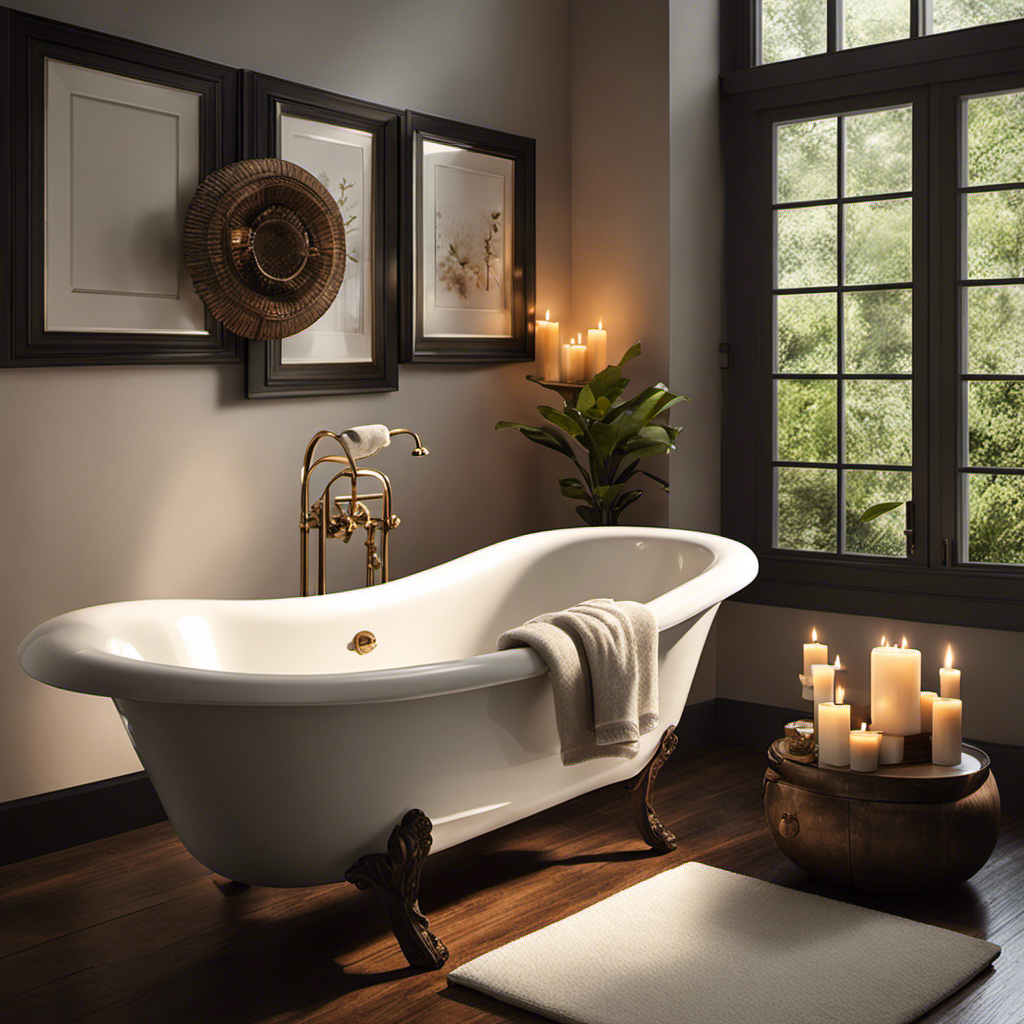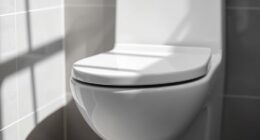As someone who loves a good soak after a long day, I know the struggle of trying to find comfort in a small bathtub. But fear not, because I’ve discovered some secrets to transforming even the tiniest of tubs into a luxurious oasis.
By choosing the right bathtub accessories, maximizing space, and creating a relaxing atmosphere with cushions and pillows, you can turn your compact bathtub into a haven of relaxation.
Let me share with you my tips and tricks for making a small bathtub surprisingly comfortable.
Key Takeaways
- Utilize bathtub accessories and organization tools to maximize space and keep essentials within reach
- Enhance the atmosphere with dimmable lights, aromatherapy, and soothing scents
- Incorporate cushions and pillows for optimal comfort and support
- Consider incorporating spa-like features such as hydrotherapy jets and essential oils for a luxurious bathing experience
Choosing the Right Bathtub Accessories
When choosing the right bathtub accessories, it’s important to consider items that will enhance comfort and relaxation.
One key aspect to consider is bathtub organization. Keeping your essentials within reach can greatly improve your bathing experience. A shower caddy or a bathtub tray can help you neatly arrange your soap, shampoo, and other toiletries, ensuring they are easily accessible.
Another way to enhance your bathing experience is by adding a splash of color. Choose towels, bath mats, and shower curtains in vibrant hues that complement your bathroom decor. These colorful accessories not only add visual appeal but also create a soothing and inviting atmosphere.
Maximizing Space in a Small Bathtub
To maximize space in your tiny tub, consider using a shower caddy to organize your toiletries. Not only will it keep everything within reach, but it will also free up valuable space in your bathtub.
Here are four space-saving bathtub designs and built-in storage solutions to make your small bathtub more comfortable:
-
Corner Bathtub: Opt for a corner bathtub that fits snugly into the corner of your bathroom. This design utilizes the often-unused corner space and maximizes the available area in your tub.
-
Built-in Shelves: Install built-in shelves on the walls surrounding your bathtub. These shelves provide convenient storage for towels, bath products, and other essentials, keeping them easily accessible while saving space in your tub.
-
Under Tub Storage: Choose a bathtub with built-in storage compartments underneath. These hidden storage spaces are perfect for stashing away extra towels, toiletries, or cleaning supplies, keeping your bathtub clutter-free.
-
Hanging Organizers: Hang organizers on the back of your bathroom door or on the shower curtain rod. These organizers can hold toiletries, loofahs, and other small items, maximizing vertical space in your bathroom.
Creating a Relaxing Atmosphere
Creating a relaxing atmosphere in your tiny tub can be achieved by incorporating soft lighting, soothing music, and scented candles.
When it comes to lighting options for a soothing ambiance, consider using dimmable lights that can be adjusted to your desired level of brightness. Install recessed lights or wall sconces around the tub area to create a warm and inviting glow. You can also use LED strip lights under the rim of your bathtub for a subtle and calming effect.
To enhance relaxation, try incorporating aromatherapy techniques. Add a few drops of essential oils such as lavender or chamomile to your bathwater to promote relaxation and relieve stress. You can also use aromatherapy candles or diffusers to fill the air with soothing scents.
Enhancing Comfort With Cushions and Pillows
For added comfort in your tiny tub, consider using cushions and pillows to support your body and create a cozy atmosphere. Here are four reasons why incorporating these customized solutions with ergonomic designs can make a world of difference in your bathing experience:
-
Optimal Body Support: The right cushions and pillows can provide targeted support to different parts of your body, alleviating pressure points and ensuring a comfortable soak.
-
Enhanced Relaxation: By adding soft cushions and plush pillows, you can transform your small bathtub into a luxurious oasis where you can unwind and let go of the day’s stresses.
-
Improved Blood Circulation: Ergonomic designs promote proper body alignment, helping to improve blood flow and reduce muscle tension, allowing you to fully enjoy your time in the tub.
-
Personalized Comfort: With a variety of shapes, sizes, and materials available, you can customize your cushions and pillows to suit your specific needs and preferences, ensuring the ultimate in comfort and relaxation.
Incorporating Spa-like Features
Now, let’s explore how you can enhance your bathing experience in the tiny tub by incorporating spa-like features such as soothing jets and aromatherapy options.
When it comes to creating a luxurious and relaxing atmosphere, hydrotherapy benefits cannot be overlooked. These powerful jets provide a gentle massage that can help to ease muscle tension and promote relaxation. Imagine the feeling of warm water cascading over your body, melting away the stresses of the day.
Additionally, incorporating aromatherapy options can further enhance your experience. By adding a few drops of your favorite essential oil to the water, you can create a soothing and invigorating scent that fills the air as you soak. Whether you prefer calming lavender or refreshing eucalyptus, these scents can help to uplift your mood and create a spa-like ambiance.
Conclusion
In conclusion, making a small bathtub comfortable may seem like an impossible task, but with the right accessories and a little creativity, you can turn it into your own personal oasis.
Who needs a luxurious spa when you can create a relaxing atmosphere right in your own bathroom? From maximizing space to incorporating spa-like features, the possibilities are endless.
So go ahead, indulge in a warm bath and let your worries wash away – even in the tiniest of tubs. You deserve it.










